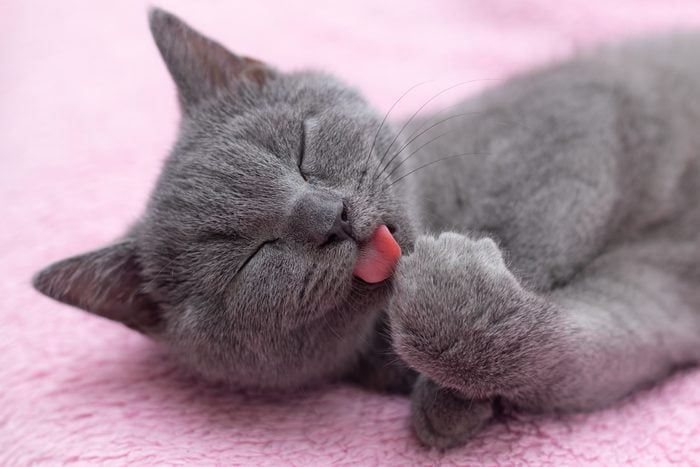
The gray cat breeds you need in your life
Every cat is beautiful, of course, but we still can’t help picking favorites. Some of us are drawn to the golden locks and big personalities of orange cats. Others can’t resist the mysterious charms of black cats. And for many, there’s nothing better than a gorgeous fur-ball gray cat breed to call their own. “There’s just something magical about gray cats,” says Teresa Keiger, an all-breed judge with the Cat Fanciers’ Association, the world’s largest registry of pedigreed cats. “They’re ethereal.” These silvery felines have also earned a great reputation for being among the friendliest cats.
Is gray a rare color for cats?
Nope. “This may break the hearts of gray cat owners, but gray cats are relatively common,” says Kristin Wuellner, DVM, a veterinarian with Hill’s Pet Nutrition. Many cat breeds include gray among their color variations. Gray cats can be large, small, fluffy and long-haired, or sleek and short-haired. You’ll find gray cats among the cutest cat breeds and also among the rarest cat breeds.
So whether you’re looking for a pet with a pedigree or one without, there’s bound to be a gray cat that will steal your heart. Here’s what you need to know about some of the sweetest gray cat breeds.
Get Reader’s Digest’s Read Up newsletter for more pets, humor, cleaning, travel, tech and fun facts all week long.
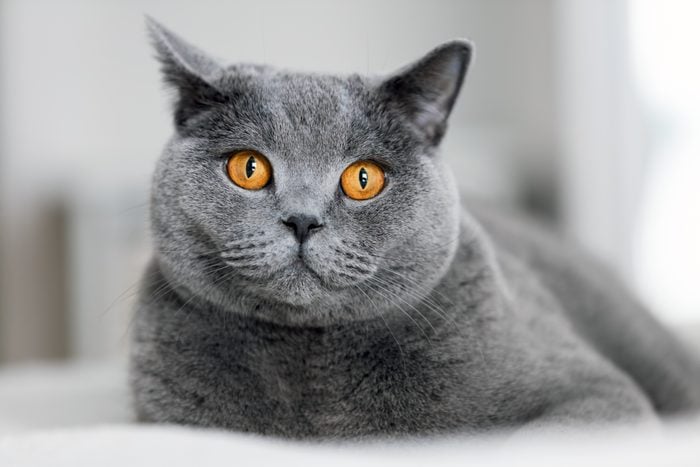
British Shorthair
With their big round eyes and plush teddy-bear-like coats, these gorgeous felines are the most popular of the pedigreed gray cat breeds. “They’re a classic,” says Keiger. She says they are also known as British Blues.
The British Shorthair is believed to be the oldest breed of British cat, tracing its ancestry back to the Roman invasion of Britain in 43 AD. (Seriously, that’s a long time ago!) And while British Shorthairs come in a variety of colors and patterns, gray is the color of choice for traditionalists. Fun fact: It was a gray tabby version of the British Shorthair that played Professor McGonagall’s feline alter-ego in Harry Potter and the Sorcerer’s Stone. British Shorthairs are not only one of the prettiest felines in cat pictures, they’re also known for being calm, easygoing and affectionate.
| Breed overview | British Shorthair |
| Weight | 7–17 pounds |
| Life expectancy | 14–20 years |
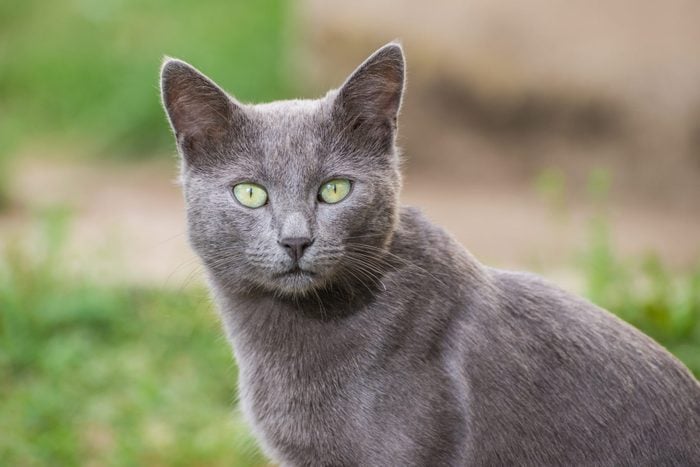
Russian Blue
With their plush silvery coats and brilliant green eyes, Russian Blues are stunning gray cat breeds. “Their coats have a soft shimmery color, so it looks like a cloud,” says Keiger, a longtime breeder of Blues. That short dense coat is not only silky to the touch, it has the extra perk of shedding less than other breeds.
But this breed’s personality is also highly appealing. They are some of the smartest and snuggliest of cats, with sweet, gentle temperaments and a fierce loyalty to their pet parents. Blues love to jump, climb and play, so plan on lots of active quality time together.
| Breed overview | Russian Blue |
| Weight | 7–12 pounds |
| Life expectancy | 15–20 years |
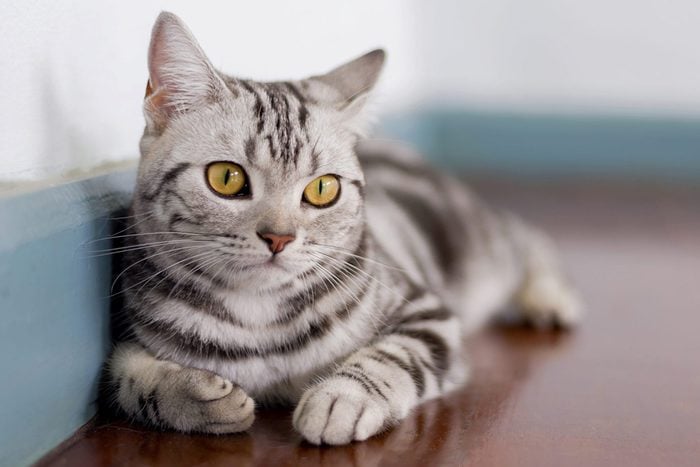
American Shorthair
This all-American gray cat breed traces its roots to the Mayflower and the other ships that ferried settlers from Europe to North America. Aboard ship, and later on land, the cats were responsible for hunting rats, which accounts for their thick muscular build.
Like their non-pedigreed cousins (known as domestic shorthairs), the American Shorthair comes in all varieties of colors and patterns, with many silver American Shorthairs (as the breed’s gray and gray-and-white tabbies are known) taking home multiple cat grand championship titles over the years. Even better: American Shorthairs are known to have playful and loving personalities, and they’re often ranked among the friendliest cat breeds.
| Breed overview | American Shorthair |
| Weight | 7–12 pounds |
| Life expectancy | 15–20 years |
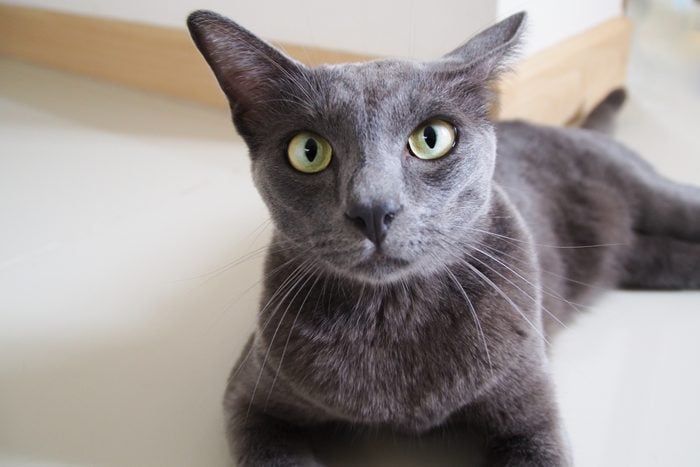
Korat
The Korat comes in only one rare color—a silver-tipped blue described in its native Thailand as “rain-cloud gray.” “They are considered to be good luck,” says Dr. Wuellner. In times of drought, Thai farmers are said to walk their Korats around the fields with the hope that their presence will summon a rainstorm.
Korats are not only one of the rarest cat breeds, they also have a reputation for being highly intelligent and can be taught various tricks. Who said only dogs can do tricks? Korats are extremely loyal and love being the center of attention. One of their most distinctive—and on-point—traits: A Korat’s head and nose are both shaped like hearts.
| Breed overview | Korat |
| Weight | 6–10 pounds |
| Life expectancy | 15–20 years |
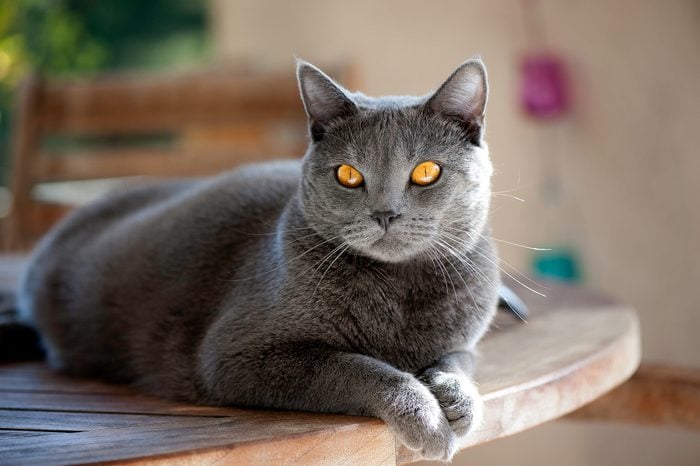
Chartreux
This slate-colored stunner is sometimes called “the smiling cat of France,” for the way their muzzles seem to taper into a smile. Legend has it, these cats were called Chartreux because they were bred by the same French monks who make the green Chartreuse liqueur. The cats were raised to have quiet voices so as not to disturb the monks’ prayers.
But there may be a different explanation: The Chartreux likely got their name because their distinctive dense coat resembled a type of 18th-century wool called “piles de Chartreux.” Today they are known for their bright copper-colored eyes and their dog-like friendliness. They even like to fetch! All cats get the zoomies, even gray cat breeds, from time to time too.
| Breed overview | Chartreux |
| Weight | 7–16 pounds |
| Life expectancy | 11–15 years |
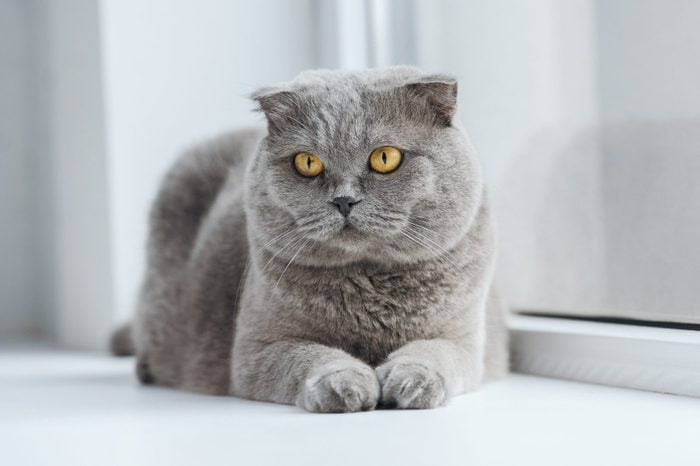
Scottish Fold
These cuddly cuties are named for a genetic mutation that causes their ears to fold forward onto their heads, making them look a little like an owl or a teddy bear. Scottish Folds are known for being as affectionate as they are darling. And while they’ve only been intentionally bred since the 1960s, they have quickly captured the hearts of cat lovers. Taylor Swift loves them so much she has two, named Meredith Grey and Olivia Benson.
Scottish Folds apparently trace their lineage back to a Scottish barn cat that was named Susie. But in an unexpected twist, they don’t all have folded ears. Kittens are born with straight ears, and the folds appear when they’re about three weeks old. About half of a litter will develop the folds. The rest are still technically Scottish Folds, but are usually called Scottish Shorthairs.
| Breed overview | Scottish Fold |
| Weight | 6–13 pounds |
| Life expectancy | 13–15 years |
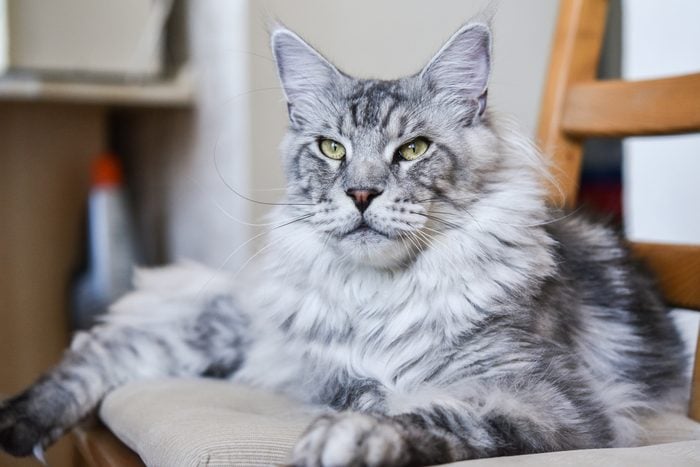
Maine Coon
The gentle giant of the cat world, the Maine Coon is a gray cat breed that’s one of the largest cat breeds on record (some have measured up to 40 inches in length!). They also have big hearts to match. In fact, the breed is often ranked among the most loving. Their gentle, outgoing nature makes them a favorite of families with young kids, and they’ve even been called “dog-like” because of their big personalities and love of play. Unlike most of their feline cousins, they even tend to enjoy water.
Maine Coon is the only long-haired breed native to the United States, and they developed many of their distinctive characteristics by learning to cope with the harsh New England winters. Their heavy, shaggy coat keeps them warm, and their massive tufted paws help them navigate deep snow.
| Breed overview | Maine Coon |
| Weight | 9–18 pounds |
| Life expectancy | 10–15 years |
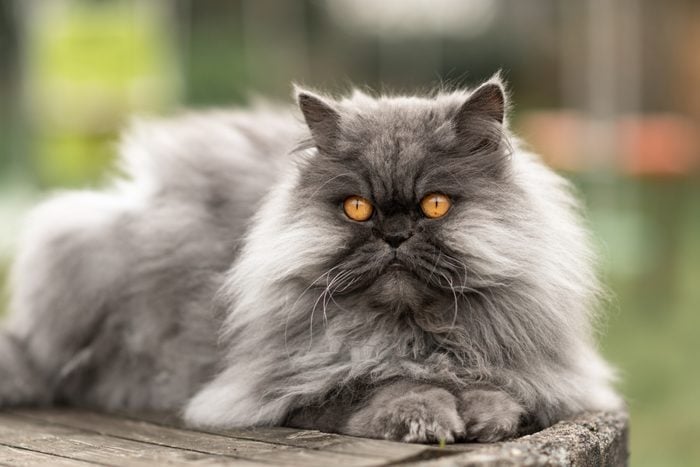
Persian
With their glossy long coats and cute snubbed noses, Persians have long been royalty in the cat world. Queen Victoria was the proud owner of multiple Persian cats in the 1800s, and when this gray cat breed was introduced to the United States at the end of that century, it became an immediate status symbol.
Today, Persians come in more than 80 different color combinations, but floofy gray Persians remain particularly striking. (Here’s a tip on the best pet-hair removers if you have one of these cuties. You’re welcome.) In case you didn’t know, there’s some disagreement these days about what constitutes the perfect Persian look. In recent decades, show standards for Persians favored an almost flat-face, a look called “pansy-like.” But some breeders argue that an extremely short muzzle can lead to breathing issues.
| Breed overview | Persian |
| Weight | 7–14 pounds |
| Life expectancy | 15–20 years |
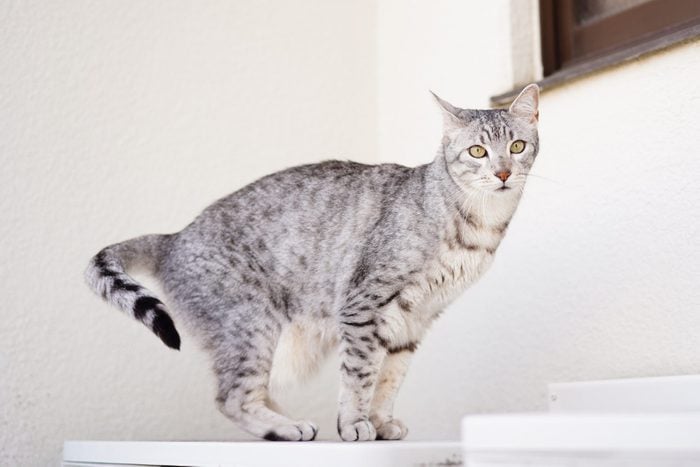
Egyptian Mau
With their exotic spotted coats and lightning-fast reflexes, Egyptian Maus look like they should be stalking in the Serengeti alongside their wild big-cat cousins. But the Mau is believed to come from a different part of the African continent: ancient Egypt. They were considered sacred there, and mau was the Egyptian word for cat. Frescoes and drawings dating back as far as 1550 B.C. depict spotted cats that look quite similar to the Egyptian Mau of today.
Whatever their divine legacy, this stunning and social gray cat breed is now known for their athletic body language and prowess (they have reportedly been clocked at running speeds of up to 30 mph!), their gorgeous green eyes and their natural intelligence.
| Breed overview | Egyptian Mau |
| Weight | 6–14 pounds |
| Life expectancy | 12–15 years |
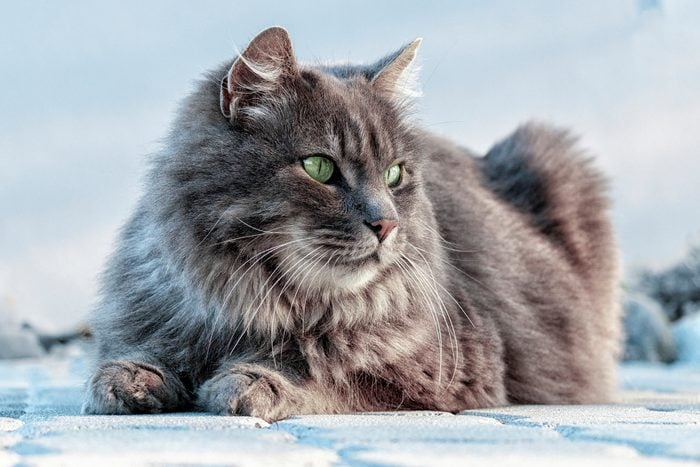
Siberian
No surprise, these gorgeous furball beauties are regularly ranked as one of the cutest gray cat breeds, and their personality is equally winning. Fearless and easygoing, they love to play and are known to be friendly and affectionate with their human families.
Siberian cats have been a staple in Russian books and fairy tales for centuries, but it wasn’t until after the Cold War ended that the breed made its way to America. Because of their roots in the subarctic climate of Northern Russia, they are built for winter survival with dense, water-resistant coats, tufted ears and bushy tails designed to protect them from the cold.
| Breed overview | Siberian |
| Weight | 8–17 pounds |
| Life expectancy | 11–15 years |
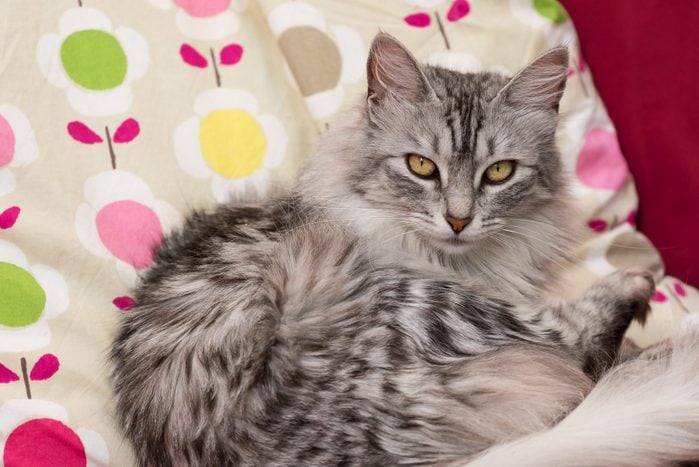
Turkish Angora
Turkish Angoras were the toast of 18th-century France, and these lithe, fluffy beauties apparently strolled the halls of Versailles alongside Marie Antoinette. By the early 1900s, the breed had all but disappeared. But thanks to preservation efforts in their native Turkey, Angoras are no longer in danger of disappearing forever. And while traditionally Angoras were white, they now come in a full range of colors and patterns, including a gorgeous gray. They’re known for their soft, silky coats and athletic grace and are sometimes referred to as the ballerina of the cat world.
| Breed overview | Turkish Angora |
| Weight | 5–10 pounds |
| Life expectancy | 12–18 years |
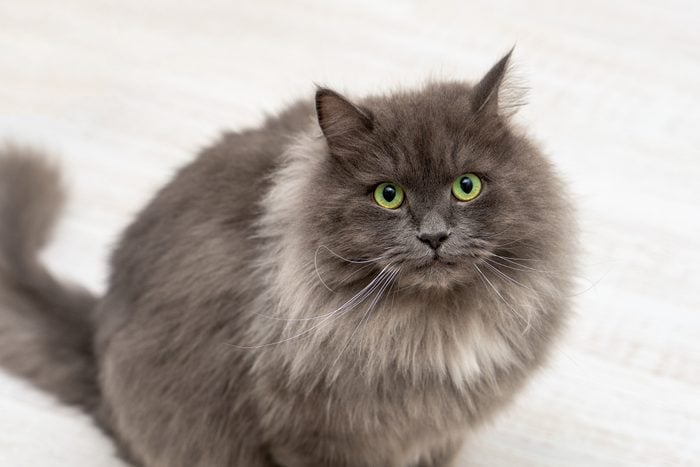
Nebelung
These gorgeous smoky charmers look like a long-haired version of the Russian Blue. But they’re actually a relatively new gray cat breed that was developed in the 1980s. They trace their roots to some domestic cats whose owner thought they looked like Russian Blues with long hair, says Keiger. Those two non-pedigreed cats were named Siegfried and Brunhilde, characters in the Wagner opera The Ring of the Nibelung, and the Nebelung’s name is a play on that title as well as the German word nebel, meaning mist or fog. How’s that for an interesting cat fact? Although the Nebelung is not yet recognized by the CFA, it has been recognized by other cat registries.
| Breed overview | Nebelung |
| Weight | 7–15 pounds |
| Life expectancy | 15–18 years |
Sources:
- Teresa Keiger, all-breed judge with The Cat Fanciers’ Association
- Kristin Wuellner, DVM, veterinarian at Hill’s Pet Nutrition
- The Cat Fanciers’ Association: “CFA Breeds”
